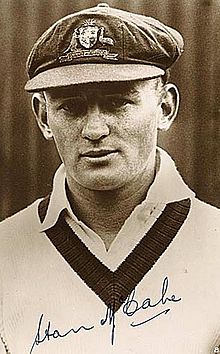 McCabe in 1930 | ||||||||||||||||||||||||||||||||||||||||
| Personal information | ||||||||||||||||||||||||||||||||||||||||
|---|---|---|---|---|---|---|---|---|---|---|---|---|---|---|---|---|---|---|---|---|---|---|---|---|---|---|---|---|---|---|---|---|---|---|---|---|---|---|---|---|
| Full name | Stanley Joseph McCabe | |||||||||||||||||||||||||||||||||||||||
| Born | 16 July 1910 Grenfell, New South Wales, Australia | |||||||||||||||||||||||||||||||||||||||
| Died | 25 August 1968 (aged 58) Mosman, New South Wales, Australia | |||||||||||||||||||||||||||||||||||||||
| Nickname | Napper | |||||||||||||||||||||||||||||||||||||||
| Batting | Right-handed | |||||||||||||||||||||||||||||||||||||||
| Bowling | Right-arm medium pace | |||||||||||||||||||||||||||||||||||||||
| Role | All-rounder | |||||||||||||||||||||||||||||||||||||||
| International information | ||||||||||||||||||||||||||||||||||||||||
| National side | ||||||||||||||||||||||||||||||||||||||||
| Test debut (cap 134) | 13 June 1930 v England | |||||||||||||||||||||||||||||||||||||||
| Last Test | 24 August 1938 v England | |||||||||||||||||||||||||||||||||||||||
| Domestic team information | ||||||||||||||||||||||||||||||||||||||||
| Years | Team | |||||||||||||||||||||||||||||||||||||||
| 1928–1941 | New South Wales | |||||||||||||||||||||||||||||||||||||||
| Career statistics | ||||||||||||||||||||||||||||||||||||||||
| ||||||||||||||||||||||||||||||||||||||||
Source: CricketArchive, 29 February 2008 | ||||||||||||||||||||||||||||||||||||||||
Stanley Joseph McCabe (16 July 1910 – 25 August 1968)[1] was an Australian cricketer who played 39 Test matches for Australia from 1930 to 1938. A short, stocky right-hander, McCabe was described by Wisden as "one of Australia's greatest and most enterprising batsmen" and by his captain Don Bradman as one of the great batsmen of the game.[2] He was never dropped from the Australian Test team[3] and was known for his footwork, mastery of fast bowling and the hook shot against the Bodyline strategy. He also regularly bowled medium-pace and often opened the bowling at a time when Australia lacked fast bowlers, using an off cutter. He was one of the Wisden Cricketers of the Year in 1935.[4]
At the age of 19, McCabe was called up for the 1930 tour of England despite being yet to score his maiden first-class century as the selectors chose the youngest ever team to leave Australia. McCabe made his first century in a warm-up match but struggled in his month in England, scoring only 51 runs. His performance began to improve after adjusting his technique and he played in all five Tests, although he continued to have problems converting starts into large scores, failing to make a century during the tour. McCabe managed to maintain his position over the next two home seasons, playing in all ten Tests, but failed to make a century, and after 15 Tests, his average was below 35 although he had become increasingly successful at first-class level.
In 1932–33, McCabe made his breakthrough at international level in the First Test of the infamous Bodyline series, scoring an unbeaten 187 at the Sydney Cricket Ground in only four hours as his teammates fell around him. McCabe attacked the bowling vigorously, hooking relentlessly. He ended the series as the only Australian other than Bradman to score a century. McCabe missed most of the next season due to illness, but was retained for the 1934 tour of England despite his interrupted preparation. He scored 2,078 runs and eight centuries for the tour, including his maiden Test century in England. Following the retirement of captain Bill Woodfull at the end of the tour, McCabe became Australia's vice-captain and held the post for the rest of his career.
After missing most of the 1934–35 domestic season due to injury, McCabe scored an unbeaten 189 in the Second Test of the 1935–36 tour of South Africa, including a century in one session, taking Australia to the brink of a world record-breaking victory on a difficult final-day pitch in poor light before the match was called off. It was one of two Test centuries McCabe made on the tour. The following season, he made five fifties in the first four Tests before scoring a century to help Australia win the deciding final Test against the touring Englishmen. In the First Test of the 1938 tour of England, McCabe played what was regarded as his greatest innings, scoring 232 in four hours, including his last 72 in 28 minutes. Bradman regarded the innings as the greatest batting he ever saw. However, none of McCabe's three most famous innings resulted in an Australian victory; he has a reputation of being at his best when Australia was in difficulty.
During the 1938 tour, McCabe had been generally unproductive and he missed much of the subsequent Australian season due to illness and only played sporadically thereafter before cricket was cancelled due to World War II. He served in the military in a clerical position for a year before he was discharged due to chronic feet problems. McCabe was plagued by poor health in his middle age, and was hospitalised for a liver ailment shortly before his death. He died at the age of 58 after falling off a cliff adjacent to his home in Mosman. There was innuendo that it was a suicide, but the coroner ruled that it was an accident.
- ^ Cite error: The named reference
adbwas invoked but never defined (see the help page). - ^ Don Bradman at Cricinfo retrieved 5 March 2008
- ^ Cashman; Franks; Maxwell; Sainsbury; Stoddart; Weaver; Webster (1997). The A-Z of Australian cricketers. pp. 197–198.
- ^ Haigh, Gideon. "Players and Officials – Stan McCabe". Cricinfo. Retrieved 12 January 2007.